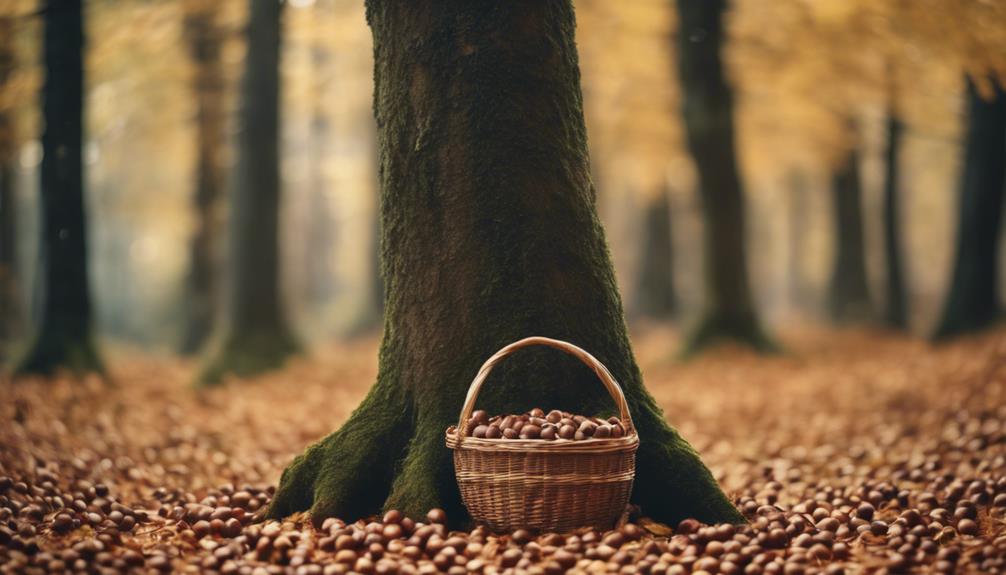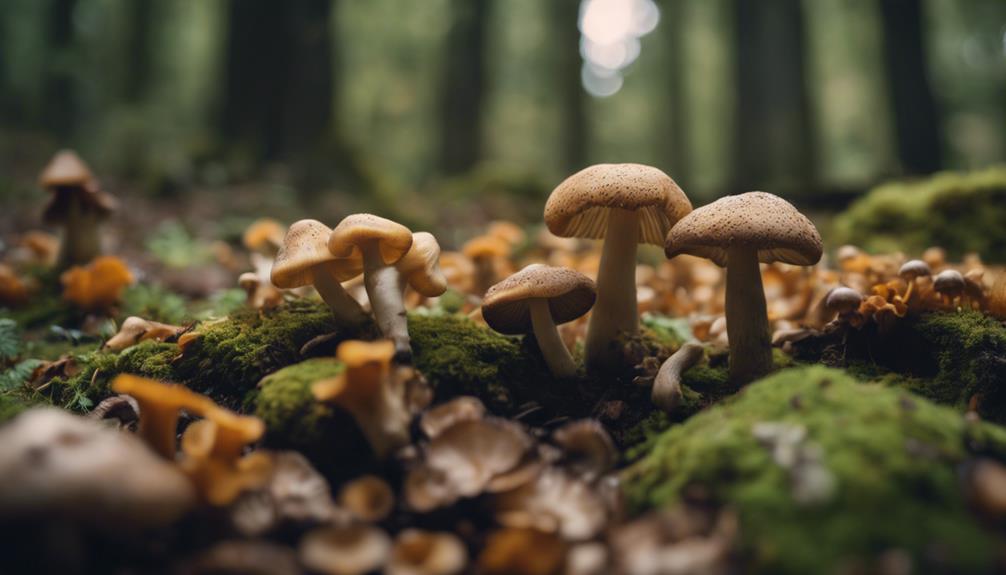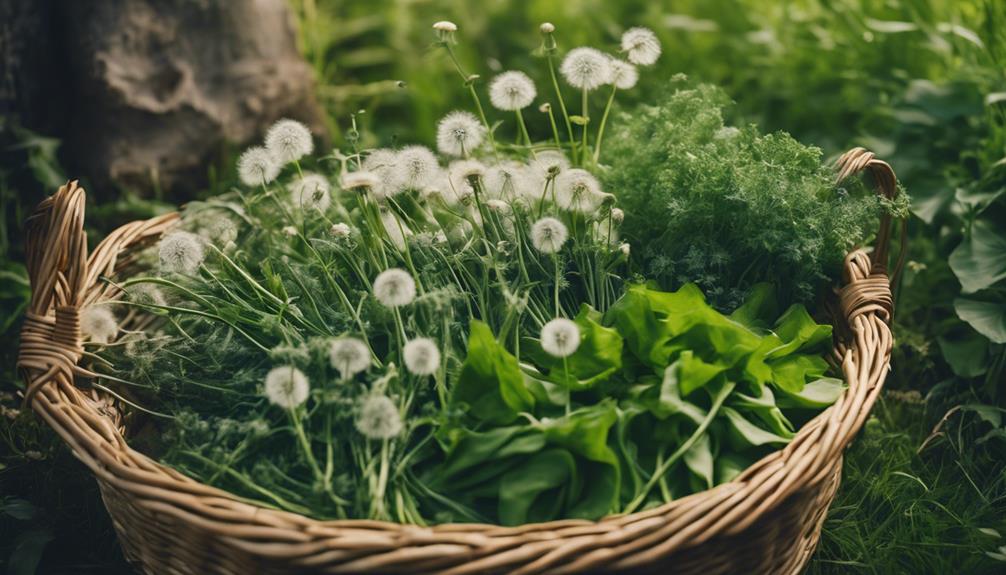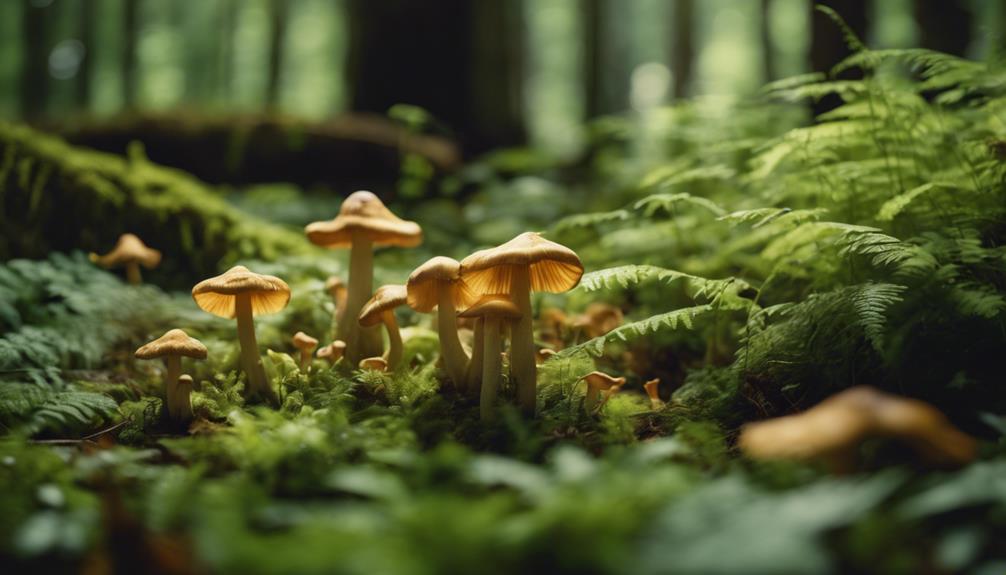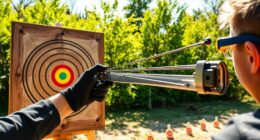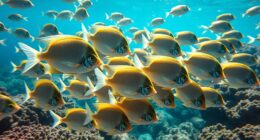You can forage for chestnuts, and with the right techniques and knowledge, you can enjoy this nutritious and flavorful nut while promoting sustainable harvesting practices and preserving the environmental value of chestnut trees. To get started, scan the ground for naturally fallen nuts, looking for light brown, shiny husks with a defined line around the top. Be sure to distinguish between edible sweet chestnuts and toxic horse chestnuts. By following safe foraging and handling practices, you'll be able to enjoy roasted chestnuts in a variety of dishes. Continue to learn more about the best tips and techniques for foraging and preparing chestnuts.
Key Takeaways
- Identify ripe chestnuts by looking for light brown, shiny husks with a defined line around the top, and avoid unripe ones with a white line across the middle.
- Distinguish between edible sweet chestnuts and toxic horse chestnuts, and handle them with clean hands to prevent contamination.
- Roast chestnuts at high temperatures for at least 30 minutes, making a deep cross cut on the bottom before roasting for easy peeling.
- Store roasted chestnuts in the freezer for up to 6 months, and thaw and use as desired for various recipes while maintaining flavor and texture.
- Respect private property boundaries, obtain necessary permits, and harvest only what you need, leaving no trace behind to promote sustainable foraging practices.
Identifying Ripe Chestnuts in Nature
When foraging for chestnuts, start by scanning the ground for nuts that have fallen naturally, as these are likely to be ripe and ready for harvest. You'll want to identify ripe chestnuts, which typically have light brown, shiny husks, indicating freshness. Look for chestnuts with a defined line around the top, a clear sign of ripeness. Avoid unripe chestnuts, which often have a white line across the middle. Ripe chestnuts will have fallen to the ground naturally, making them easy to spot.
As you forage for chestnuts, remember to prioritize effective processing. Organize your harvested chestnuts by size to guarantee efficient roasting. This simple step will save you time and energy in the long run.
Chestnut Types and Their Uses

As you've mastered the art of identifying ripe chestnuts, you're now ready to explore the diverse world of chestnut varieties and their many uses.
You'll discover that sweet chestnuts are edible and a staple in many cuisines, while horse chestnuts are toxic and not suitable for consumption.
When trying sweet chestnuts for the first time, you'll notice their unique flavor and texture, which pairs well with savory and sweet recipes. Roasting chestnuts enhances their natural sweetness, making it a cozy experience during colder months.
You'll find that different chestnut varieties may have varying sizes, flavors, and textures, offering endless possibilities for culinary experimentation and creativity. Whether you're using them in stuffing, soups, or desserts, chestnuts add a nutty, slightly sweet flavor that's associated with positive experiences.
On either side of the culinary spectrum, chestnuts can elevate your dishes and provide a delicious twist. So, don't be afraid to get creative and explore the many uses of this versatile ingredient!
Safe Foraging and Handling Practices

As you venture out to forage for chestnuts, remember that safety should be your top priority.
You'll want to make sure you're picking the right species, handling them with clean hands, and avoiding any that show signs of mold or rot.
Identify Edible Species
To guarantee a safe and enjoyable foraging experience, you must be able to distinguish between edible sweet chestnuts and toxic horse chestnuts, which can be a matter of life and death. Make sure you can identify the distinct features of sweet chestnuts, such as their pointed shape, tufted tip, and single, oblong leaves.
Avoid horse chestnuts, which have rounded shapes, lack tufts, and have palm-shaped, edgeless leaves. When foraging for chestnuts, always positively identify the species to ensure safety and enjoyment. Come back to this critical step repeatedly, as it's vital to your well-being.
Thank you so much for taking the time to learn about safe foraging practices. By following these guidelines, you'll be able to enjoy the delicious and nutritious sweet chestnuts while avoiding the toxic horse chestnuts.
Handle With Clean Hands
You're now ready to focus on handling your foraged chestnuts safely, a step just as important as identifying the right species, since improper handling can render your bounty useless or even hazardous to your health. To guarantee your chestnuts remain safe and healthy, it's essential to handle them properly. Here are some essential tips to keep in mind:
| Handling Tips | Why It Matters |
|---|---|
| Wash your hands | Prevents contamination |
| Wear gloves | Protects from irritants/allergens |
| Avoid open cuts/wounds | Prevents infection |
| Keep away from chemicals | Maintains safety and quality |
| Proper handling practices | Ensures safe consumption |
Avoid Moldy or Rotten
When foraging for chestnuts, it's important to carefully inspect each one for signs of mold or rot, as consuming spoiled chestnuts can be harmful to your health. You should avoid any chestnuts that show signs of mold, rot, or decay, as they can contain harmful toxins. These toxins can cause serious health issues if ingested, so it's vital to be selective when choosing which chestnuts to harvest.
To guarantee a safe and enjoyable foraging experience, you should discard any chestnuts that show signs of spoilage. Proper handling practices involve carefully examining each chestnut for signs of mold or rot before adding it to your collection. By being vigilant and selective, you can ensure that the chestnuts you collect are safe to eat.
Roasting and Peeling Techniques Compared

By experimenting with different roasting and peeling techniques, you can greatly enhance the flavor and texture of your foraged chestnuts. To reveal the best results, roast your chestnuts at high temperatures of 190 degrees Celsius or above for at least 30 minutes. Before roasting, make a deep cross cut on the bottom of each chestnut to prevent them from exploding during cooking.
When it comes to peeling, you'll find that boiling your chestnuts before roasting can make the process much easier. After roasting, let the chestnuts cool before peeling off the skins for a more manageable and enjoyable experience.
You might choose to remove the inner skin as well, as some people find it has a bitter taste. However, it's edible and up to personal preference.
Storing and Preserving Chestnuts Properly

Now that you've mastered the art of roasting and peeling, it's important to learn how to store and preserve your chestnuts properly to maintain their flavor and texture.
You've put in the effort to forage and prepare your chestnuts, so you want to make sure they stay fresh for a longer period. Luckily, roasted chestnuts can be stored in the freezer for up to 6 months for future use. This way, you can enjoy them in various recipes, such as nut roasts, stuffing, desserts, or as a crunchy snack.
When you're ready to use them, simply thaw and use as desired. Proper storage and preservation will help maintain the nutty flavor and texture you've come to love.
Benefits of Foraging for Chestnuts

You reap a multitude of benefits when you forage for chestnuts, from harvesting a nutrient-dense food to fostering a deeper connection with nature. As you venture out to forage, you'll not only collect a rich source of essential vitamins and minerals like B6, B9, and C, as well as Potassium, Magnesium, Iron, and Zinc, but you'll also experience the satisfaction of finding, harvesting, and cooking your own nutritious and flavorful ingredients.
Chestnuts are packed with antioxidants, making them a valuable addition to a healthy diet when foraged fresh. Foraging promotes physical activity, reduces food waste, and encourages a connection with nature. By foraging for chestnuts, you'll discover local, seasonal foods while supporting sustainable practices and enjoying the outdoors. This activity allows you to slow down, appreciate the natural world, and cultivate a sense of self-sufficiency.
As you forage, you'll develop a deeper appreciation for the land, the seasons, and the simple joys of finding and preparing your own food.
Ethical Considerations for Foragers

As you head out to forage for chestnuts, it's important to keep in mind that responsible foraging practices are just as vital as finding the perfect tree. You should always respect private property rights and obtain permission before harvesting chestnuts. This guarantees you're not trespassing or damaging someone's land.
It's also essential to harvest only what you need, avoiding overexploitation of the trees and ensuring their sustainability. Remember to leave no trace while foraging, minimizing your impact on the environment and preserving natural habitats. Avoid disturbing wildlife habitats as well, maintaining ecological balance.
Lastly, be mindful of sharing your knowledge and foraging spots with others, promoting ethical foraging practices. By following these guidelines, you'll not only find the best chestnuts but also contribute to the conservation of these magnificent trees. By being responsible and respectful, you'll ensure that future generations can enjoy the thrill of foraging for chestnuts as much as you do.
Frequently Asked Questions
How to Forage for Chestnuts?
When foraging for chestnuts, you'll identify the right trees by their pointy nuts and single, sharp-edged leaves, then collect fallen, ripe nuts, sorting them by size for easy roasting and use in your favorite recipes.
What Is the Best Way to Harvest Chestnuts?
You'll find the best chestnuts by harvesting them when they fall, as they're easier to pick up, and you'll know they're ripe due to their golden brown color and defined line around the top.
What Month Do You Pick Chestnuts?
You typically pick chestnuts in autumn, usually between September and November, but the exact month varies depending on your region and climate, so monitor the ripening process to determine the best time.
How Do You Pick the Best Chestnuts?
When picking the finest chestnuts, you'll want to select ones that are light brown, shiny, and free of wrinkles or sunken areas, avoiding squishy or damaged ones for peak flavor and quality.
Conclusion
You've learned the ins and outs of foraging for chestnuts, from identifying ripe ones to storing and preserving them properly.
You might be thinking, 'But what about the potential for allergic reactions or contamination?' Rest assured, with proper handling and storage, the benefits of foraging for chestnuts far outweigh the risks.
By being mindful of safe foraging practices, you can enjoy this nutritious and delicious food source while minimizing the chances of adverse reactions. Always be sure to properly identify plants before harvesting and avoid areas that may have been exposed to pesticides or other contaminants. Educate yourself about any potential look-alikes that may be toxic, as this can help prevent dangerous mistakes. Similarly, when feeding goats forage, it’s essential to ensure the plants they’ve grazed on are safe and non-toxic to avoid health issues within the herd.
Happy foraging!

